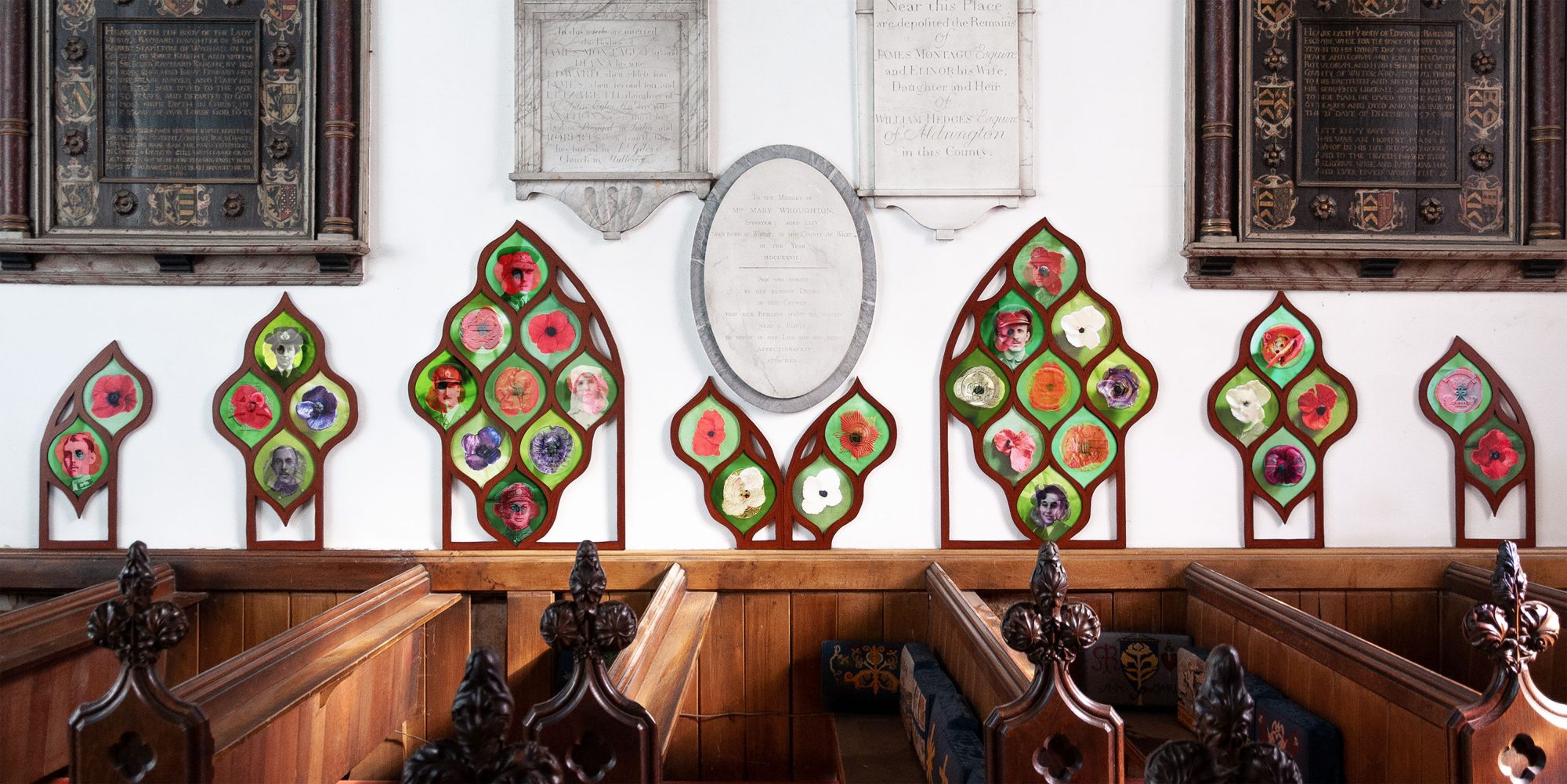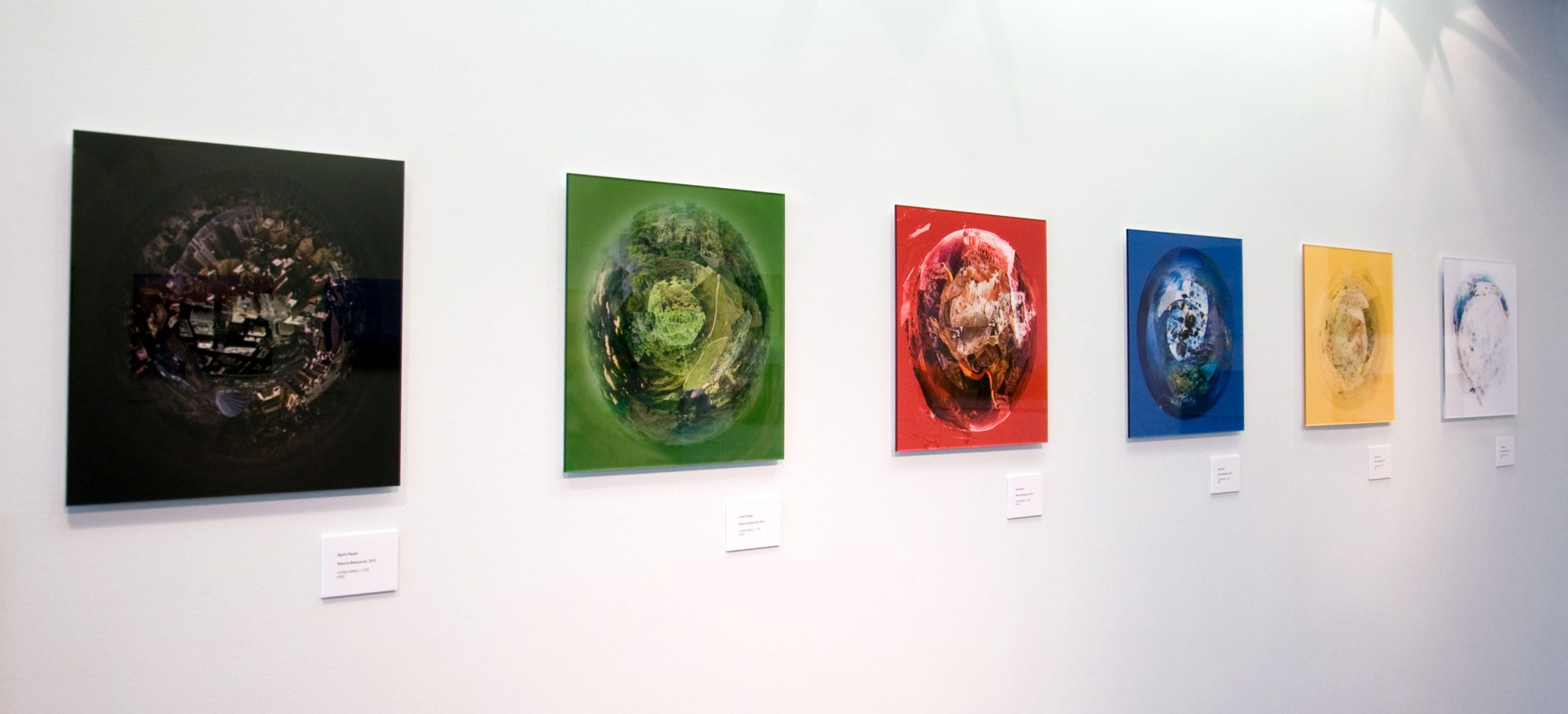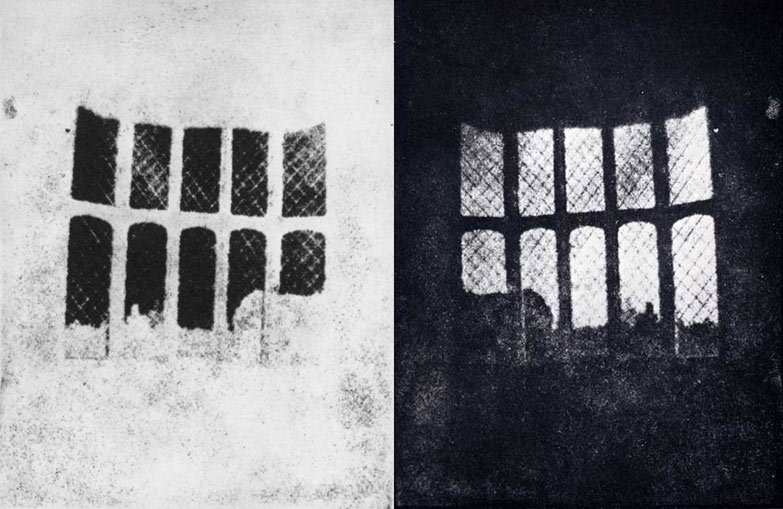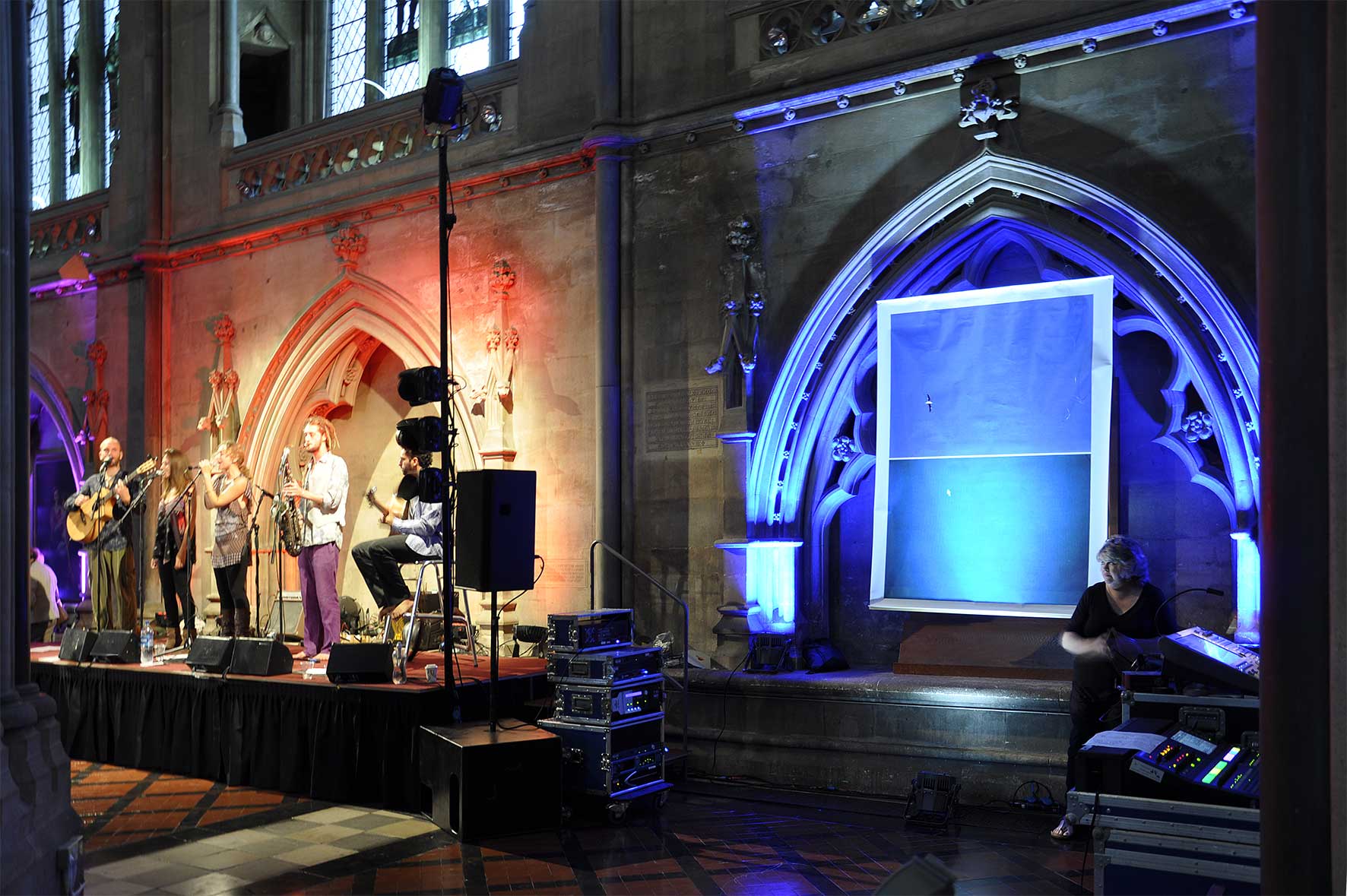NOTEBOOK SPOTLIGHT: Remembrance Rood Screen
This is an 8-panel, 35-aperture photographic installation, displayed in the south transept at St Cyriac’s Church, Lacock. Remembrance Rood Screen commemorates the service and commitment shown by local servicemen and women during the First World War. The piece is the culmination of a community art project in which residents were invited to share their photographs, medals, clippings and other objects connected to war time.
24 images feature lenticular photography, with a dissolve effect appearing to change the images as the viewer passes in front of them, while the total of 35 photographs represents the number of men named on the Lacock, Notton, and Bowden Hill war memorials. Portraits include those of Major Charles Selwyn Awdry and Major Allen Llewellen Palmer, as well as those of Matilda Talbot serving at the Red Cross Hospital in Corsham, and Ivy Gladstone at the Chippenham and Bowood Red Cross Hospitals. Other images include a Soldier’s Penny given to Ernest Leonard Stevens, an engraved communion cup presented to St Cyriac’s in memory of Basil William Ramsbottom, and a shell casing. The poppies in the images were made out of clay by the 1st Lacock Scout Group in 2018.
The project began in 2018 when I was commissioned by the Parochial Church Council at St Cyriac’s Church, and supported by Wiltshire Scrapstore, initially as part of Lacock Remembers. These wider celebrations marked the centenary of the end of the First World War, and the church community wanted to support specific responses by groups and individuals in the village. As the project took hold, both my own research and the community involvement grew: I interviewed several local families, I photographed collections of cap pins and photo albums, I pored over records at the Wiltshire and Swindon History Centre (whose Lacock Unlocked project proved invaluable), and with the Lacock History Group.
I owe a debt of thanks to the many people who helped make this project happen. Living and remembered, the community has been shaped by the war in myriad ways, and though loss is part of this picture, so is gratitude and love. It is this richly patterned picture which I hope my work reflects, borrowing as it does from the idea of saints as supportive figures who mediate reflection and worship in church buildings.
Afterword (January 2021): When the piece was unveiled in October 2019, it took the form of a temporary installation in the south transept. The frames, whose design followed the ogee patterning of the choir stalls, were hand-cut from mdf. Plans to permanently install the work using reclaimed wood from church furnishings were under consideration by the Diocesan Fabric Committee, but were later shelved when the pandemic hit in 2020.
Header image: Remembrance Rood Screen (installation view), 2019, by Sheona Beaumont.
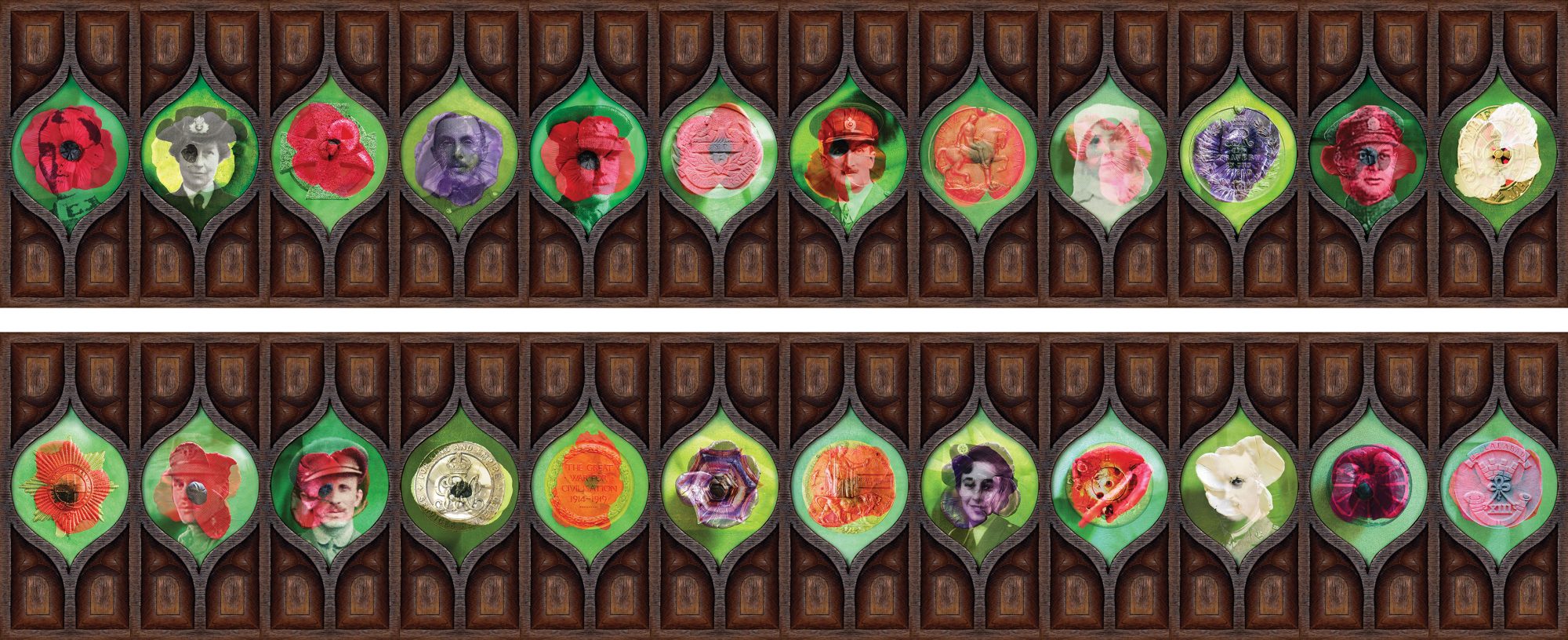
The complete list of subjects (l-r, beginning with top row) is as follows:
1. 2nd Lieutenant Carol Edward Vere Awdy, 2nd Battalion, Royal Munster Fusileers. K.I.A.27/08/1914, Fesmy, north France, buried nr. Etreux and commemorated on the Notton War Memorial. Photograph from De Ruvigny’s Roll of Honour 1914-1918.
2. Matilda (Maude) Talbot, Voluntary Aid Detachment (VAD) for the Red Cross Hospital, Corsham from 26/10/1914 until 1916, at a convalescents’ hospital in France 1917, and Women’s Royal Navy Service (WRNS) 1918-1919 in Cranwell, Lincolnshire. Buried in Lacock Cemetery. Photograph from the Wiltshire & Swindon History Centre 2664/3/1F/15.
3. War memorial, St Anne’s Church, Bowden Hill. Photograph from Janet Doel.
4. Herbert George Selman, Son Frederick Edwin George Selman died in the Second World War. Photograph from Rachael McHenry.
5. Major Allen Llewellen Palmer, 1st Wiltshire Yeomanry. D.15/11/1916 in hospital in Amiens, France, buried at St. Pierre Cemetery and commemorated on the Lacock War Memorial. Photograph from from De Ruvigny’s Roll of Honour 1914-1918.
6. Headstone for Private Edward Bath, 7th Somerset Regiment. D.30/11/1917, buried in St Anne’s Churchyard, Bowden Hill, and commemorated on the Lacock War Memorial and at Cambrai, Louveral. ‘Egypt / Gloucestershire’.
7. Brigadier Sir Eric Holt-Wilson, Imperial Security Intelligence Service during the First World War (which would later become MI5). Buried in St Anne’s Churchyard. Photograph from Clemency Holt-Wilson.
8. British War Medal. ‘1914 / 1918’, also showing Saint George on horseback trampling on the Prussian eagle shield.
9. Ivy Gladstone, Voluntary Aid Detachment (VAD) for the Red Cross Hospitals in Chippenham and Bowood, 1916-1919. Ivy (working as a nurse) and her sister Olive (a cook) were daughters of Mr & Mrs John Evelyn Gladstone of Bowden Park, Lacock. Photograph from the Lacock History Group.
10. Military medal (Corporal William Collett, Royal Field Artillery d.27/10/1917, commemorated on the Lacock War Memorial and at Tyne Cot, Belgium). ‘For bravery in the field’, with the royal cypher GVR.
11. Alfred George Self, Rifle Brigade, London Regiment. D.10/01/1919, buried in Lacock Cemetery and commemorated on the Lacock War Memorial. Photograph from Sian Hunt.
12. The Church Lads’ Brigade cap badge (Richard Elmes, 16th Kings Royal Rifle Corps, d.15/07/1916, commemorated on the Lacock War Memorial and the Thiepval Memorial to the Missing of the Somme).
13. Coldstream Guards cap badge (Walter Feltham, 3rd Battalion, Coldstream Guards, d.23/03/1918, commemmorated on the Bowden Hill War Memorial and the Arras Memorial, Pas-de-Calais).
14. Lieutenant Sanford William Shippard, 1st North Lancashire Regiment, d.10/07/1917 and commemorated on the Lacock War Memorial. Photograph from findagrave.com.
15. Captain Frank Fitzroy Spicer, 12th Royal Lancers. Awarded Distinguished Service Order (DSO), and the Military Cross (MC). Owner of Spye Park, Bowden Hill.
16. Silver War Badge (for those invalided out of service). ‘For King and Empire. Services Rendered’, with the royal cypher GRI (Georgius Rex Imperator).
17. Victory Medal. ‘THE GREAT / WAR FOR / CIVILISATION / 1914-1919’.
18. Communion cup, dedicated to Lieutenant Basil William Ramsbottom, 12th Norfolk Yeomanry, K.I.A.19/08/1918. Buried Morbecque, and commemorated on the Lacock War Memorial. Basil was the son of Revd William Ramsbottom, vicar of St Cyriac’s Lacock, who gave the chalice and paten to the church in memory of Basil.
19. Soldier’s Penny, Private Ernest Leonard Stevens, 1st Battalion Wiltshire Regiment. K.I.A.02/07/1918, buried Kassel, Germany and commemorated on the Lacock War Memorial.
20. Mary Gatley, radar operator in the Second World War. Photograph from Lacock Unlocked website.
21. Used shell from the First World War (owned by Jennie Harding).
22. Major Charles Selwyn Awdry, 6th Battalion, Wiltshire Regiment. K.I.A.25/03/1918 near Bapaume, north France, commemorated on the Notton War Memorial and at Pozières. Awarded the Distinguished Service Order (DSO). Photograph from Winchester College.
23. Tank wheel (Private George Goodwin Cook, Machine Gun Corps Heavy Branch. D.15/09/1916, and commemorated on the Lacock War Memorial and the Thiepval Memorial to the Missing of the Somme). The first use of a tank occurred on this day in the First World War. Photograph from Alamy of a Mark1 tank.
24. Headstone (Private Cyril Chivers, 11th Hampshire Regiment). D.17/06/1918, buried St Anne’s Churchyard, Bowden Hill, next to his two brothers Edgar and Edward who also died in the First World War. Commemorated on the Lacock War Memorial and Pernes British Cemetery, Pas-de-Calais. ‘Jellalabad’ refers to the Taunton barracks.
(photographs by Sheona Beaumont unless otherwise stated)
